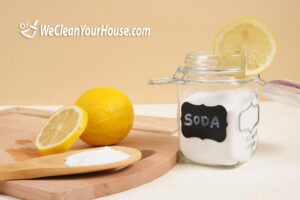Introduction
In today’s world, where environmental concerns are at the forefront of global discussions, adopting eco-friendly practices has become increasingly important. This extends to every aspect of our lives, including the way we clean our homes and workplaces. Eco-friendly cleaning not only benefits the environment but also promotes healthier living conditions for ourselves and future generations.

Understanding Eco-Friendly Cleaning
Green cleaning involves using products and methods that are safe for both human health and the environment. Unlike conventional cleaning products, which often contain harmful chemicals and toxins, eco-friendly alternatives prioritize natural, non-toxic ingredients.
Benefits
Switching to green cleaning products offers a myriad of benefits. Firstly, it promotes better indoor air quality and reduces the risk of respiratory issues and allergies. Additionally, it minimizes the release of harmful pollutants into the environment, thus helping to preserve ecosystems and wildlife. Moreover, in the long run, it can also save money by reducing the need for expensive cleaning products.
Common Ingredients

Many everyday household items can be repurposed as green cleaning solutions. Baking soda, vinegar, lemon juice, and essential oils are just a few examples of versatile ingredients that can effectively clean surfaces while being gentle on the environment.
Transitioning to Eco-Friendly Cleaning Products
Making the switch to green cleaning products begins with educating yourself about harmful chemicals commonly found in traditional cleaners. By reading labels and familiarizing yourself with potentially harmful ingredients, you can make informed choices when purchasing cleaning products. Alternatively, you can create your own cleaning solutions using simple ingredients like vinegar and water.
Tools and Equipment

In addition to using green cleaning products, investing in sustainable cleaning tools and equipment can further reduce your environmental footprint. Microfiber cloths, reusable spray bottles, and steam cleaners are all eco-friendly alternatives to disposable cleaning supplies.
Tips for Sustainable Cleaning Practices
Practicing sustainability goes beyond the products you use—it also involves minimizing water usage, choosing reusable options over disposable ones, and properly disposing of waste. By incorporating these habits into your cleaning routine, you can significantly reduce your environmental impact.
Incorporating Eco-Friendly Habits into Daily Life
Transitioning to green cleaning practices may require some adjustment, but with proper planning and commitment, it can easily become a seamless part of your daily routine. Setting achievable goals and involving your family members in the process can make the transition smoother and more sustainable in the long term.
Overcoming Challenges
While the benefits of green cleaning are undeniable, it’s essential to acknowledge and address the challenges that may arise. Initial cost concerns, adjusting to new routines, and overcoming skepticism from others are common obstacles that can be overcome with patience and persistence.
Case Studies of Successful Eco-Friendly Cleaning Transitions
Real-life examples of successful transitions to green-cleaning practices serve as inspiration for others looking to make similar changes. Whether it’s individuals sharing their personal experiences or businesses implementing eco-friendly initiatives, these case studies demonstrate the feasibility and impact of sustainable cleaning practices.
Supporting Green Cleaning Brands and Initiatives
Choosing to support ethical companies that prioritize sustainability is another way to contribute to the green-cleaning movement. By researching brands and participating in community clean-up events, you can actively promote environmentally conscious practices in your community.
Measuring Success
Measuring the success of your green cleaning efforts goes beyond just visible results. Tracking changes in your health, monitoring your environmental impact, and calculating your financial savings over time are all valuable indicators of the effectiveness of your green cleaning practices.
Addressing Common Misconceptions
Despite the numerous benefits of green cleaning, there are still misconceptions that may deter some individuals from making the switch. Addressing concerns about effectiveness, time and effort required, and the accessibility of ingredients can help dispel these myths and encourage more people to adopt sustainable cleaning practices.
Future of Eco-Friendly Cleaning

As awareness of environmental issues continues to grow, the future of eco-friendly cleaning looks promising. Technological advancements, global trends towards sustainability, and individual efforts to take personal responsibility for their environmental impact all point towards a future where eco-friendly cleaning is the norm rather than the exception.
Conclusion
In conclusion, eco-friendly cleaning is not only beneficial for the environment but also for our health and well-being. By making simple changes to the way we clean our homes and workplaces, we can significantly reduce our ecological footprint and create a safer, healthier environment for ourselves and future generations.
Frequently Asked Questions (FAQs)
- Is eco-friendly cleaning as effective as traditional cleaning methods?
- Yes, eco-friendly cleaning methods can be just as effective as traditional methods, if not more so. Natural ingredients like vinegar and baking soda are powerful cleaners that can tackle dirt and grime effectively.
- Are eco-friendly cleaning products more expensive?
- While some green cleaning products may have a higher initial cost, they often last longer and can save money in the long run. Additionally, many household items can be repurposed as eco-friendly cleaners, reducing the need to purchase specialized products.
- Do eco-friendly cleaning products have any negative side effects?
- Generally, green cleaning products are safer for both humans and the environment compared to traditional cleaners. However, it’s essential to use them as directed and be mindful of any allergies or sensitivities to specific ingredients.
- Can I make my own eco-friendly cleaning products at home?
- Yes, many green cleaning solutions can be made using simple ingredients found in your pantry, such as vinegar, baking soda, and lemon juice. There are numerous recipes available online for homemade cleaning products.
- What are some tips for transitioning to eco-friendly cleaning practices?
- Start by educating yourself about harmful chemicals commonly found in traditional cleaners. Then, gradually replace these products with green alternatives and incorporate sustainable cleaning habits into your routine.
Read Also: Top 5 Green Cleaning Products for a Sparkling Home

